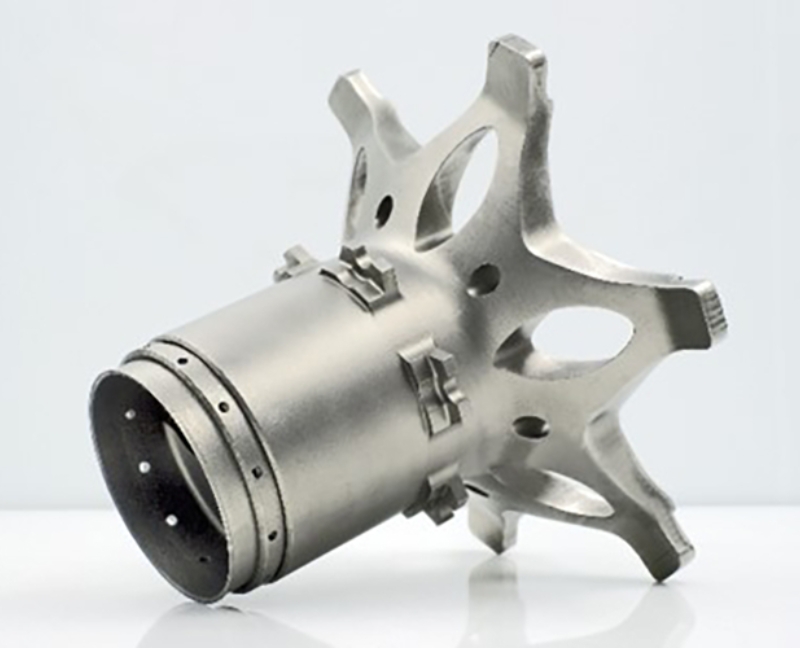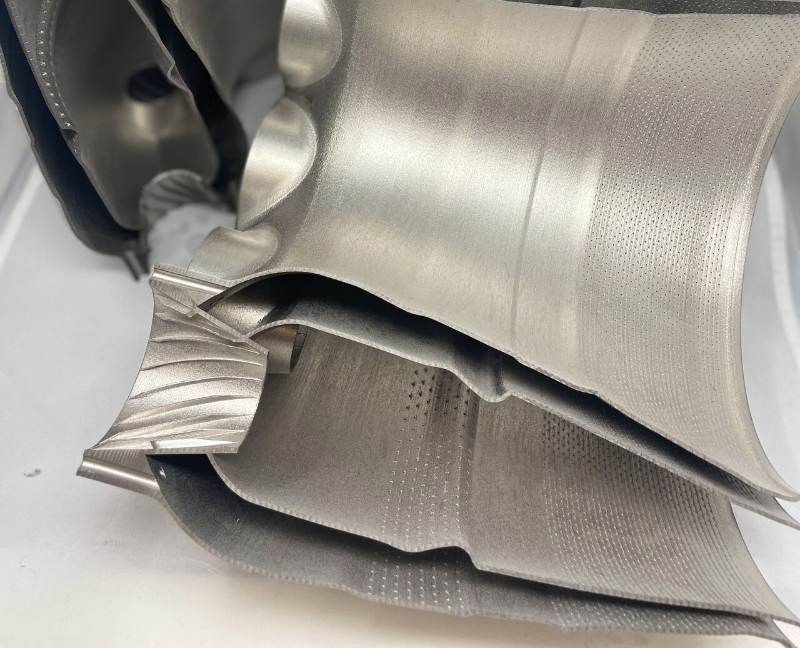Haynes 282, a wrought, gamma-prime strengthened nickel-based superalloy (UNS N07208), is engineered for high-temperature structural applications, particularly in aerospace and industrial gas turbine engines. Renowned for its exceptional creep strength, thermal stability, weldability, and fabricability, Haynes 282 outperforms many commercial alloys in demanding environments. This guide explores the alloy’s material properties, machining characteristics, heat treatment processes, product forms, and applications across industries like aerospace, energy, and automotive. Detailed parameters, technical insights, and industry considerations provide a comprehensive understanding of Haynes 282, highlighting its role in advancing high-performance engineering.
Material Properties of Haynes 282
Haynes 282 is designed to combine high-temperature strength with improved manufacturability, addressing limitations of other gamma-prime strengthened nickel-based superalloys like Waspaloy and R-41. Its unique composition and microstructure enable superior performance in extreme conditions, making it a preferred material for critical components.
High-Temperature Strength
Haynes 282 exhibits outstanding creep strength in the temperature range of 1200–1700°F (649–927°C). Its creep resistance surpasses that of Waspaloy and approaches R-41, with a creep life exceeding 100,000 hours at 14.5 ksi (100 MPa) and 1400°F (760°C). The alloy’s strength is attributed to a relatively low volume fraction of the gamma-prime (γ') phase, which enhances resistance to strain-age cracking while maintaining mechanical integrity.
Thermal Stability
The alloy maintains structural stability at elevated temperatures, resisting phase transformations and degradation. Its thermal fatigue properties ensure reliability in cyclic loading conditions, such as those encountered in gas turbine engines. Haynes 282’s thermal stability supports long-term performance in applications like Advanced Ultra-Supercritical (A-USC) boilers and supercritical CO2 power cycles.
Weldability and Fabricability
Unlike many high-strength superalloys, Haynes 282 offers excellent weldability due to its slow gamma-prime precipitation kinetics. This property minimizes strain-age cracking during welding, enabling seamless and flash butt-welded rings with minimal defects. The alloy’s ductility in the as-annealed condition facilitates forming processes, achieving elongation values of up to 30%. Its fabricability supports complex geometries, such as combustor liners and turbine nozzles.
Corrosion Resistance
Haynes 282 provides robust corrosion resistance in oxidative and high-temperature environments, making it suitable for hot-gas-path components in gas turbines. Its nickel-based matrix, enriched with chromium and molybdenum, forms a protective oxide layer, ensuring durability in corrosive atmospheres like those in aerospace and energy applications.

Machining Haynes 282
Machining Haynes 282 presents challenges due to its high strength, work-hardening tendencies, and low thermal conductivity. However, with optimized techniques, such as finish turning using coated carbide tools and conventional coolant, high-quality results are achievable. Key machining parameters, including cutting speeds, feeds, and tool wear, are critical to ensuring precision and efficiency.
Finish Turning with Coated Carbide Tools
Finish turning of Haynes 282 typically employs coated carbide tools, such as those with TiAlN or AlTiN coatings, to enhance wear resistance and thermal stability. Cutting speeds range from 30–60 m/min, with feed rates of 0.1–0.3 mm/rev and depths of cut between 0.5–1.5 mm. Conventional coolant, such as water-based emulsions, reduces thermal stresses and improves surface finish, achieving surface roughness values of Ra 0.8–1.6 μm.
Machining Forces
Machining forces in Haynes 282 are higher than those for softer alloys due to its strength and work-hardening behavior. Typical cutting forces range from 500–1000 N, depending on cutting speed and feed rate. Lower speeds (e.g., 30 m/min) reduce forces but increase tool wear, while higher speeds (e.g., 60 m/min) improve efficiency but require robust coolant systems to manage heat.
Tool Wear and Life
Tool wear in Haynes 282 machining is primarily due to abrasive wear and thermal fatigue. Coated carbide tools exhibit flank wear rates of 0.1–0.3 mm after 10–15 minutes of continuous cutting at 40 m/min. Tool life typically ranges from 20–40 minutes under optimal conditions, with coolant application extending life by 20–30%. Advanced coatings and intermittent cutting strategies further mitigate wear.
Surface Roughness
Surface roughness is a critical quality metric in Haynes 282 machining. Optimized parameters achieve Ra 0.8–1.6 μm, suitable for aerospace components requiring smooth surfaces to minimize fatigue crack initiation. Higher feed rates (e.g., 0.3 mm/rev) increase roughness to Ra 2.0 μm, necessitating post-machining polishing for critical applications.
Heat Treatment of Haynes 282
Heat treatment is essential to unlock Haynes 282’s high-strength properties and ensure performance in demanding environments. The alloy is typically supplied in the solution-annealed condition, with subsequent age-hardening treatments to optimize strength and creep resistance.
Solution Annealing
Solution annealing is performed at temperatures of 2050–2100°F (1121–1149°C) for 1–2 hours, followed by rapid cooling (e.g., water or air quenching). This process dissolves secondary phases, enhances ductility (elongation up to 30%), and prepares the alloy for forming and machining. The annealed microstructure ensures excellent weldability and formability.
Age Hardening
Age hardening involves a two-step process to precipitate the gamma-prime phase, enhancing strength. The standard treatment includes:
- 1850°F (1010°C) for 2 hours, followed by air cooling.
- 1450°F (788°C) for 8 hours, followed by air cooling.
This treatment achieves a yield strength of 700–900 MPa and creep resistance up to 1700°F (927°C). For Advanced Ultra-Supercritical (A-USC) and supercritical CO2 applications, a single-step age-hardening treatment per ASME Code Case 3024 optimizes creep life beyond 100,000 hours at 1400°F (760°C).
Alternative Heat Treatments
Alternative heat treatments are available to tailor properties for specific applications. For example, adjusting the aging temperature to 1400–1500°F (760–816°C) enhances low-cycle fatigue (LCF) resistance for turbine components. These treatments balance strength, ductility, and manufacturability, with cooling rates influencing gamma-prime particle size (typically 20–50 nm).
Product Forms and Fabrication
Haynes 282 is available in various product forms, supporting diverse manufacturing processes and applications. Its versatility in fabrication makes it a preferred material for complex components.
Available Forms
The alloy is produced in the following forms:
- Plate, Sheet, and Coil: From foil thicknesses (0.01 in, 0.25 mm) to plates over 2 in (50 mm) thick.
- Bar and Wire: Diameters up to 9 in (230 mm).
- Reforge Billet and Ingot: Diameters from 4–20 in (100–500 mm).
- Pipe and Tube: Seamless and welded, in standard sizes.
- Vacuum Castings and Powder: For additive manufacturing and precision components.
Fabrication Methods
Haynes 282 supports multiple fabrication techniques, including:
- Sheet and Plate Fabrication: Cutting, forming, and welding for combustor liners and exhaust sections.
- Seamless and Flash Butt-Welded Rings: For turbine seals and nozzles, with weld joint efficiencies of 95–100%.
- Closed Die Forgings: For high-strength components like turbine blades, achieving grain sizes of ASTM 6–8.
- Direct Machining: From bar or plate, with tolerances of ±0.05 mm.
The alloy’s machinability is comparable to Waspaloy, requiring robust tooling and coolant to manage work hardening and heat buildup.

Applications of Haynes 282
Haynes 282’s unique properties make it a critical material in high-performance applications across aerospace, energy, and automotive industries.
Aerospace
In aerospace, Haynes 282 is used for gas turbine components, including combustors, turbine sections, exhaust systems, and nozzle parts. Its creep strength at 1200–1700°F (649–927°C) and low-cycle fatigue resistance ensure reliability in jet engines and industrial gas turbines. The alloy’s weldability supports seamless ring production, with joint strengths of 800–900 MPa.
Energy
Haynes 282 is a strong candidate for Advanced Ultra-Supercritical (A-USC) boilers, supercritical CO2 power cycles, and concentrating solar power plants. Its creep life exceeding 100,000 hours at 14.5 ksi (100 MPa) and 1400°F (760°C) meets stringent requirements for long-term operation. ASME Code Case 3024 ensures compliance with boiler and turbine standards.
Automotive
In automotive applications, Haynes 282 is used for turbocharger components, such as seals and high-temperature springs. Its thermal stability and corrosion resistance at 1200–1500°F (649–816°C) enhance performance in high-performance vehicles, with components achieving fatigue lives of 10^6 cycles under cyclic loading.
Challenges and Solutions in Machining Haynes 282
Machining Haynes 282 requires addressing challenges related to its high strength, work hardening, and thermal properties.
Work Hardening
Haynes 282’s tendency to work-harden increases cutting forces and tool wear. Using sharp, coated carbide tools and low feed rates (0.1–0.2 mm/rev) minimizes surface hardening, maintaining tolerances of ±0.05 mm.
Thermal Management
The alloy’s low thermal conductivity concentrates heat at the cutting zone, accelerating tool wear. High-pressure coolant (e.g., 70–100 bar) dissipates heat, reducing temperatures by 20–30% and extending tool life to 30–40 minutes.
Tool Selection
Coated carbide tools with TiAlN or AlTiN coatings are preferred for their hardness and thermal resistance. Advanced tools, such as ceramic or CBN inserts, can be used for high-speed machining (up to 100 m/min), achieving surface roughness of Ra 0.4–0.8 μm.
Conclusion
Haynes 282 stands as a cornerstone material in high-performance engineering, offering a unique blend of creep strength, thermal stability, and manufacturability. Its applications in aerospace, energy, and automotive industries underscore its versatility, while advanced machining and heat treatment techniques ensure precision and reliability. By addressing challenges like work hardening and thermal management, manufacturers can harness the alloy’s full potential, driving innovation in demanding environments.
FAQ: Haynes 282
What is Haynes 282, and what are its key properties?
Haynes 282 is a nickel-based superalloy (UNS N07208) with exceptional creep strength at 1200–1700°F (649–927°C), thermal stability, weldability, and fabricability. Its creep life exceeds 100,000 hours at 14.5 ksi (100 MPa) and 1400°F (760°C), making it ideal for aerospace and energy applications.
How is Haynes 282 machined?
Haynes 282 is machined using coated carbide tools with cutting speeds of 30–60 m/min, feed rates of 0.1–0.3 mm/rev, and conventional coolant. This achieves surface roughness of Ra 0.8–1.6 μm and tool life of 20–40 minutes.
What heat treatments are used for Haynes 282?
Haynes 282 undergoes solution annealing at 2050–2100°F (1121–1149°C) and a two-step age-hardening process at 1850°F (1010°C) for 2 hours and 1450°F (788°C) for 8 hours, achieving yield strengths of 700–900 MPa.
What industries use Haynes 282?
Aerospace, energy, and automotive industries use Haynes 282 for gas turbine components, A-USC boilers, supercritical CO2 power cycles, and turbocharger parts due to its high-temperature strength and corrosion resistance.
